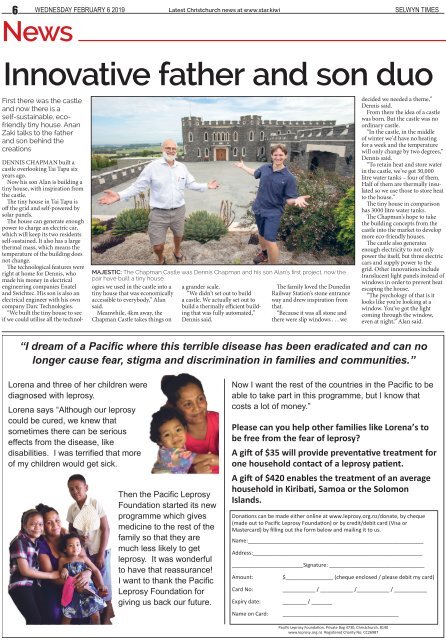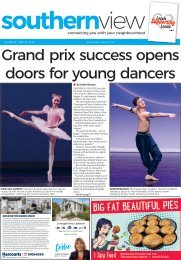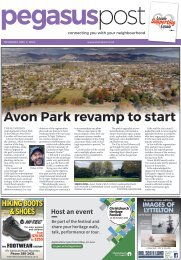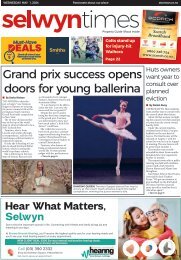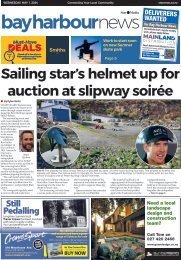Selwyn Times: February 06, 2019
Create successful ePaper yourself
Turn your PDF publications into a flip-book with our unique Google optimized e-Paper software.
6 Wednesday <strong>February</strong> 6 <strong>2019</strong><br />
Latest Christchurch news at www.star.kiwi<br />
SELWYN TIMES<br />
News<br />
Innovative father and son duo<br />
First there was the castle<br />
and now there is a<br />
self-sustainable, ecofriendly<br />
tiny house. Anan<br />
Zaki talks to the father<br />
and son behind the<br />
creations<br />
MAJESTIC: The Chapman Castle was Dennis Chapman and his son Alan’s first project, now the<br />
DENNIS CHAPMAN built a<br />
castle overlooking Tai Tapu six<br />
years ago.<br />
Now his son Alan is building a<br />
tiny house, with inspiration from<br />
the castle.<br />
The tiny house in Tai Tapu is<br />
off the grid and self-powered by<br />
solar panels.<br />
The house can generate enough<br />
power to charge an electric car,<br />
which will keep its two residents<br />
self-sustained. It also has a large<br />
thermal mass, which means the<br />
temperature of the building does<br />
not change.<br />
The technological features were<br />
right at home for Dennis, who<br />
made his money in electrical<br />
engineering companies Enatel<br />
and Swichtec. His son is also an<br />
electrical engineer with his own<br />
company Darc Technologies.<br />
“We built the tiny house to see<br />
if we could utilise all the technol-<br />
pair have built a tiny house.<br />
ogies we used in the castle into a<br />
tiny house that was economically<br />
accessible to everybody,” Alan<br />
said.<br />
Meanwhile, 4km away, the<br />
Chapman Castle takes things on<br />
a grander scale.<br />
“We didn’t set out to build<br />
a castle. We actually set out to<br />
build a thermally efficient building<br />
that was fully automated,”<br />
Dennis said.<br />
The family loved the Dunedin<br />
Railway Station’s stone entrance<br />
way and drew inspiration from<br />
that.<br />
“Because it was all stone and<br />
there were slip windows . . . we<br />
decided we needed a theme,”<br />
Dennis said.<br />
From there the idea of a castle<br />
was born. But the castle was no<br />
ordinary castle.<br />
“In the castle, in the middle<br />
of winter we’d have no heating<br />
for a week and the temperature<br />
will only change by two degrees,”<br />
Dennis said.<br />
“To retain heat and store water<br />
in the castle, we’ve got 30,000<br />
litre water tanks – four of them.<br />
Half of them are thermally insulated<br />
so we use those to store heat<br />
to the house.”<br />
The tiny house in comparison<br />
has 3000 litre water tanks.<br />
The Chapman’s hope to take<br />
the building concepts from the<br />
castle into the market to develop<br />
more eco-friendly houses.<br />
The castle also generates<br />
enough electricity to not only<br />
power the itself, but three electric<br />
cars and supply power to the<br />
grid. Other innovations include<br />
translucent light panels instead of<br />
windows in order to prevent heat<br />
escaping the house.<br />
“The psychology of that is it<br />
looks like you’re looking at a<br />
window. You’ve got the light<br />
coming through the window,<br />
even at night,” Alan said.<br />
“I dream of a Pacific where this terrible disease has been eradicated and can no<br />
longer cause fear, stigma and discrimination in families and communities.”<br />
Lorena and three of her children were<br />
diagnosed with leprosy.<br />
Lorena says “Although our leprosy<br />
could be cured, we knew that<br />
sometimes there can be serious<br />
effects from the disease, like<br />
disabilities. I was terrified that more<br />
of my children would get sick.<br />
Then the Pacific Leprosy<br />
Foundation started its new<br />
programme which gives<br />
medicine to the rest of the<br />
family so that they are<br />
much less likely to get<br />
leprosy. It was wonderful<br />
to have that reassurance!<br />
I want to thank the Pacific<br />
Leprosy Foundation for<br />
giving us back our future.<br />
Now I want the rest of the countries in the Pacific to be<br />
able to take part in this programme, but I know that<br />
costs a lot of money.”<br />
Please can you help other families like Lorena’s to<br />
be free from the fear of leprosy?<br />
A gift of $35 will provide preventative treatment for<br />
one household contact of a leprosy patient.<br />
A gift of $420 enables the treatment of an average<br />
household in Kiribati, Samoa or the Solomon<br />
Islands.<br />
Donations can be made either online at www.leprosy.org.nz/donate, by cheque<br />
(made out to Pacific Leprosy Foundation) or by credit/debit card (Visa or<br />
Mastercard) by filling out the form below and mailing it to us.<br />
Name:___________________________________________________________<br />
Address:_________________________________________________________<br />
________________________Signature: ________________________________<br />
Amount:<br />
Card No:<br />
Expiry date:<br />
Name on Card:<br />
$________________ (cheque enclosed / please debit my card)<br />
___________ / ___________ /___________ / ___________<br />
________ / _______<br />
_______________________________________<br />
Pacific Leprosy Foundation, Private Bag 4730, Christchurch, 8140<br />
www.leprosy.org.nz Registered Charity No: CC26987


